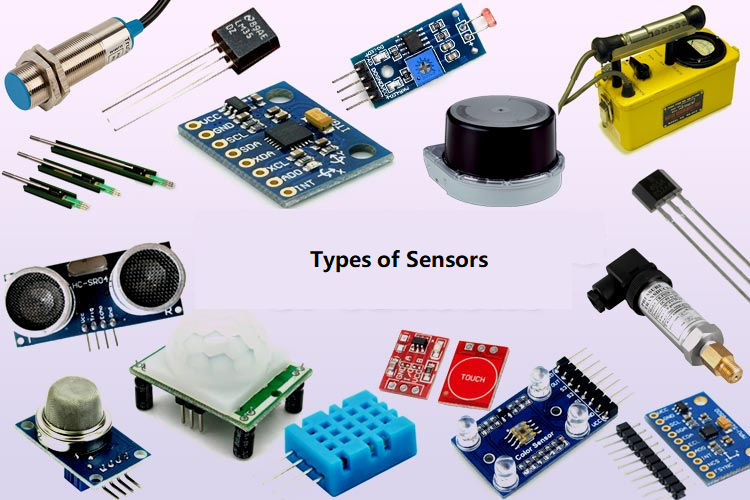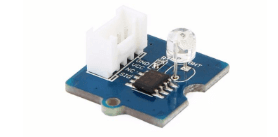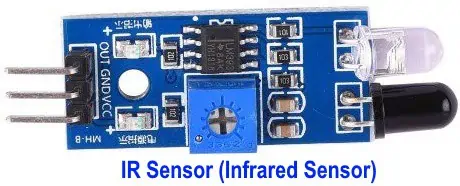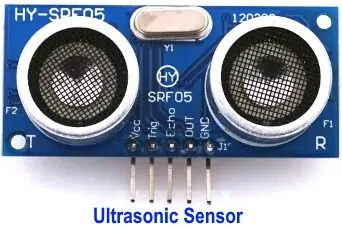A sensor is a device or a module that detects and measures physical or chemical phenomena such as temperature, pressure, light, sound, or motion, and then converts the measured signal into an electrical or digital signal that can be processed by other devices.
Sensors are widely used in a variety of applications, including automotive systems, industrial control, medical devices, home automation, and consumer electronics. There are many types of sensors, each designed to detect a specific physical or chemical parameter. Some examples include temperature sensors, pressure sensors, proximity sensors, motion sensors, and light sensors.

1. Classification of Sensors
- Active and Passive Sensors
- Analog and Digital Sensors
2. Active Sensors:
Active sensors are the type of sensors that produces output signal with help of external excitation supply. The own physical properties of the sensor varies with respect to the applied external effect. Therefore, it is also called as Self Generating Sensors.
Active sensors require an external source of energy to operate, such as an electrical power source. These sensors emit a signal, usually in the form of electromagnetic radiation, and then measure the response or reflection of the signal. Examples of active sensors include radar systems, lidar sensors, and ultrasonic sensors. Active sensors are often used in applications that require long-range sensing or in harsh environments where other sensing methods may not be effective.
3. Passive Sensors:
Passive sensors are the type of sensors that produces output signal without the help of external excitation supply. They do not need any extra stimulus or voltage.
Passive sensors, on the other hand, do not require an external energy source to operate. These sensors detect and measure natural energy emissions from their surroundings, such as radiation emitted by an object or ambient light. Examples of passive sensors include infrared sensors, temperature sensors, and acoustic sensors. Passive sensors are often used in applications that require high sensitivity and low power consumption, such as in medical devices and environmental monitoring systems.
Example: Thermocouple, which generates a voltage value corresponding to the heat, applied. It does not require any external power supply.
In summary, active sensors emit energy and measure the response, while passive sensors detect energy emissions from their surroundings.
4. What are the Difference Between Active Sensors and Passive Sensors ?
Here’s a table summarizing the main differences between active sensors and passive sensors:
| Parameter | Active Sensors | Passive Sensors |
|---|---|---|
| Power Source | Require an external power source to operate | Do not require an external power source to operate |
| Energy Emission | Emit energy to measure a response or reflection | Detect energy emissions from their surroundings |
| Sensing Range | Often have long-range sensing capabilities | Typically have short-range sensing capabilities |
| Sensitivity | Generally less sensitive than passive sensors | Generally more sensitive than active sensors |
| Energy Consumption | Typically consume more energy than passive sensors | Typically consume less energy than active sensors |
| Examples | Radar systems, LIDAR sensors, ultrasonic sensors | Infrared sensors, temperature sensors, acoustic sensors |
| Applications | Harsh environments, long-range sensing, obstacle detection | Medical devices, environmental monitoring, temperature control |
It’s worth noting that this table provides a general overview and there may be some overlap in certain applications or specific types of sensors.

5. Common Types of Sensors
There are many types of sensors available, each designed to detect a specific physical or chemical parameter. Here are some common types of sensors:
- Temperature sensors: These sensors measure the temperature of an object or environment and are used in applications such as thermostats, HVAC systems, and medical devices. Some examples include thermocouples, RTDs (resistance temperature detectors), and thermistors.
- Pressure sensors: These sensors measure the pressure of a gas or liquid and are used in applications such as automotive systems, industrial control, and medical devices. Some examples include piezoelectric sensors, strain gauge sensors, and capacitive sensors.
- Proximity sensors: These sensors detect the presence of an object without physical contact and are commonly used in manufacturing and automation systems. Some examples include ultrasonic sensors, capacitive sensors, and inductive sensors.
- Motion sensors: These sensors detect movement and are used in applications such as security systems, automatic doors, and gaming. Some examples include accelerometers, gyroscopes, and tilt sensors.
- Light sensors: These sensors detect light and are used in applications such as photography, automatic lighting systems, and display brightness controls. Some examples include photodiodes, phototransistors, and photovoltaic cells.
- Humidity sensors: These sensors measure the amount of moisture in the air and are used in applications such as weather monitoring, building automation, and agriculture. Some examples include capacitive sensors, resistive sensors, and thermal conductivity sensors.
- Magnetic sensors: These sensors detect magnetic fields and are used in applications such as automotive speedometers and compasses. Some examples include Hall effect sensors, magnetoresistive sensors, and fluxgate sensors.
- Gas sensors: These sensors detect the presence of gases and are used in applications such as air quality monitoring, industrial safety, and medical diagnostics. Some examples include electrochemical sensors, infrared sensors, and metal oxide sensors.
- pH sensors: These sensors measure the acidity or alkalinity of a solution and are used in applications such as chemical processing, water quality monitoring, and food production. Some examples include glass electrodes, ion-sensitive field-effect transistors (ISFETs), and pH indicator strips.
- Biosensors: These sensors detect biological molecules and are used in applications such as medical diagnostics, food safety, and environmental monitoring. Some examples include enzyme-based sensors, immunosensors, and DNA sensors.
There are many other types of sensors beyond these, but these examples give an idea of the diversity of sensing technologies available.
These are just a few examples of the many types of sensors available. The specific type of sensor used depends on the application and the parameter being measured.
6. Analog Sensors
Analog sensors are sensors that provide output signals that vary continuously with changes in the input parameter they are measuring. These sensors output a voltage or current signal that corresponds to the magnitude of the measured input. The output signal varies proportionally with the input signal, so small changes in the input result in small changes in the output.
Analog sensors are commonly used in a wide range of applications such as temperature measurement, pressure measurement, and position sensing. They are often used in applications where high resolution and accuracy are required, and where the range of values being measured is continuous rather than discrete. Analog sensors are typically less expensive and less complex than their digital counterparts, making them a popular choice in many applications.
Examples of analog sensors include:
- Thermocouples: These sensors measure temperature by detecting changes in voltage produced by two different metal wires.
- Strain gauges: These sensors measure the amount of deformation in a material by detecting changes in electrical resistance.
- Potentiometers: These sensors measure the position or rotation of a shaft by detecting changes in resistance.
- Pressure sensors: These sensors measure changes in pressure by detecting changes in electrical resistance, capacitance, or piezoelectric effect.
- Accelerometers: These sensors measure changes in acceleration by detecting changes in capacitance, piezoelectric effect, or electromagnetic force.
Analog sensors have some disadvantages, such as susceptibility to noise, lower accuracy compared to digital sensors, and the need for calibration to maintain accuracy. However, they are still widely used due to their simplicity, cost-effectiveness, and compatibility with existing equipment.
7. What are Digital Sensors ?
Digital sensors are sensors that provide output signals that are in the form of digital data, typically binary code, rather than continuous analog signals. These sensors typically use an on-board analog-to-digital converter (ADC) to convert the analog input signal into a digital output signal that can be easily processed by digital systems.
Digital sensors provide many advantages over analog sensors. They are more immune to noise, provide higher accuracy, and are often easier to interface with digital systems such as microcontrollers, computers, and other digital devices. Digital sensors also tend to be more versatile and flexible than analog sensors, allowing for a wider range of sensing capabilities.
Examples of digital sensors include:
- Digital temperature sensors: These sensors measure temperature and provide a digital output signal that corresponds to the temperature value. Examples include the DS18B20 temperature sensor and the LM35 temperature sensor.
- Digital humidity sensors: These sensors measure humidity and provide a digital output signal that corresponds to the humidity value. Examples include the DHT11 and DHT22 humidity sensors.
- Digital pressure sensors: These sensors measure pressure and provide a digital output signal that corresponds to the pressure value. Examples include the BMP180 and BMP280 pressure sensors.
- Digital proximity sensors: These sensors detect the presence of an object and provide a digital output signal indicating whether an object is present or not. Examples include infrared proximity sensors and ultrasonic proximity sensors.
- Digital light sensors: These sensors detect light and provide a digital output signal corresponding to the intensity of light. Examples include the TSL2561 light sensor and the BH1750 light sensor.
Digital sensors have become increasingly popular in recent years due to advancements in technology, which have led to lower costs, smaller sizes, and improved accuracy. They are commonly used in a wide range of applications, including consumer electronics, industrial automation, robotics, and healthcare.
8. What are Light Sensors?

Light sensors are sensors that detect light and provide an output signal that corresponds to the intensity of light. These sensors are commonly used in a wide range of applications, such as automatic light control systems, photography, and industrial automation.
There are several types of light sensors, including:
- Photoresistors: Also known as LDRs (light-dependent resistors), these sensors are passive components that change their resistance in response to changes in light intensity. They are typically used in low-cost applications and are sensitive to changes in ambient light.
- Photodiodes: These are active devices that convert light into an electrical current. They are often used in applications that require fast response times and high sensitivity, such as optical communications.
- Phototransistors: These are similar to photodiodes, but they have a built-in transistor that amplifies the signal. They are often used in applications that require higher sensitivity than photodiodes.
- CCDs (charge-coupled devices): These are specialized sensors used in digital cameras and other imaging applications. They work by capturing light on an array of tiny pixels and converting the light into an electrical signal.
- CMOS sensors: These are similar to CCDs, but they use a different technology to capture light. They are often used in low-cost digital cameras and other consumer electronics.
- Ambient light sensors: These sensors are used in devices such as smartphones and tablets to automatically adjust the screen brightness based on the ambient light conditions.
Light sensors are available in a wide range of sizes, sensitivities, and price ranges, making them suitable for many different applications. They can be used to measure light intensity, detect the presence or absence of light, or capture images and video.

9. What is a IR Sensor (Infrared Sensor)?
An IR (infrared) sensor, also known as an infrared detector or receiver, is a sensor that detects infrared radiation. Infrared radiation is a type of electromagnetic radiation with a longer wavelength than visible light and is typically emitted by warm or hot objects.
IR sensors are commonly used in a wide range of applications, including remote controls, security systems, and motion detectors. They work by detecting changes in the amount of IR radiation in their surroundings, which can be caused by the presence or movement of an object.
There are two main types of IR sensors:
- Passive IR sensors: These sensors do not emit any IR radiation of their own, but instead detect changes in the amount of IR radiation in their surroundings. They are commonly used in motion detectors and security systems to detect the presence or movement of people or animals.
- Active IR sensors: These sensors emit their own IR radiation and detect the amount of IR radiation that is reflected back to them. They are commonly used in remote controls and proximity sensors.
IR sensors can be further classified based on their operating wavelength. Some common types include:
- Near-infrared (NIR) sensors: These sensors operate in the range of 700 to 1400 nanometers and are commonly used in applications such as communication, spectroscopy, and medical imaging.
- Mid-infrared (MIR) sensors: These sensors operate in the range of 1400 to 3000 nanometers and are commonly used in applications such as gas sensing and thermal imaging.
- Far-infrared (FIR) sensors: These sensors operate in the range of 3000 to 1 millimeter and are commonly used in applications such as astronomy and thermal imaging.
IR sensors have many advantages over other types of sensors, including their ability to detect objects without physical contact, their ability to work in low-light conditions, and their immunity to visible light interference. However, they can be affected by factors such as temperature, humidity, and interference from other IR sources.

10. What is an Ultrasonic Sensor?
An ultrasonic sensor is a sensor that uses sound waves with frequencies above the range of human hearing (typically above 20 kHz) to detect objects and measure distances. Ultrasonic sensors are commonly used in applications such as distance measurement, object detection, and level sensing.
Ultrasonic sensors work by emitting high-frequency sound waves from a transmitter, and then detecting the reflected sound waves with a receiver. The time delay between the transmission and reception of the sound waves is used to calculate the distance between the sensor and the object. This distance measurement is based on the speed of sound through air, which is approximately 343 meters per second at room temperature.
Ultrasonic sensors are available in two types:
- Proximity sensors: These sensors are designed to detect the presence of objects within a specific range, without measuring the distance to the object. They are commonly used in applications such as parking sensors and collision avoidance systems.
- Distance sensors: These sensors are designed to measure the distance to an object. They are commonly used in applications such as level sensing and robotic navigation.
Ultrasonic sensors have many advantages over other types of sensors, including their ability to work in harsh environments and their immunity to interference from other sensors or sources of electromagnetic radiation. However, they can be affected by factors such as temperature, humidity, and the shape and material of the object being detected.
There are many examples of ultrasonic sensors used in various applications. Here are some common examples:
- Distance measurement: Ultrasonic sensors can be used to measure the distance between the sensor and an object, and are commonly used in applications such as parking sensors, object detection, and level sensing.
- Flow measurement: Ultrasonic sensors can be used to measure the flow of liquids and gases, and are commonly used in applications such as water meters and flow meters.
- Cleaning: Ultrasonic sensors can be used in cleaning applications, such as ultrasonic cleaning tanks that use high-frequency sound waves to clean delicate items such as jewelry, electronic components, and medical equipment.
- Robotics: Ultrasonic sensors are used in robotics for obstacle detection and avoidance, and are commonly used in applications such as autonomous vehicles and drones.
- Medical imaging: Ultrasonic sensors are used in medical imaging applications such as ultrasound imaging, which uses high-frequency sound waves to create images of the inside of the body.
- Welding: Ultrasonic sensors can be used in welding applications, such as ultrasonic metal welding, which uses high-frequency sound waves to join two metal parts together without the need for heat or electricity.
These are just a few examples of the many applications for ultrasonic sensors. Ultrasonic sensors have a wide range of uses due to their ability to measure distances and detect objects without physical contact.

11. Accelerometers & Gyroscope Sensors
Accelerometers and gyroscopes are two types of sensors commonly used in electronic devices to detect motion and orientation.
An accelerometer is a sensor that measures acceleration forces, such as gravity or changes in velocity. It can detect changes in motion in three dimensions (X, Y, Z), and is commonly used in applications such as mobile devices, gaming controllers, and fitness trackers to detect changes in orientation, movement, and vibration.

Gyroscopes, on the other hand, are sensors that measure angular velocity, or the rate of change of the orientation of an object. Gyroscopes can detect changes in orientation in three dimensions (X, Y, Z), and are commonly used in applications such as navigation systems, drones, and virtual reality devices.
Combined accelerometer and gyroscope sensors, also known as inertial measurement units (IMUs), are commonly used in applications that require accurate motion sensing, such as robotics, drones, and motion tracking devices.
Accelerometers and gyroscopes can be found in a variety of devices, including smartphones, smartwatches, game controllers, fitness trackers, drones, and navigation systems. They are essential components in many electronic devices that require motion sensing or orientation detection.
Here are some examples of devices and applications that use accelerometers and gyroscopes:
- Smartphones: Most modern smartphones include built-in accelerometers and gyroscopes that allow for various motion sensing features, such as screen rotation, tilt-based gaming, and step tracking.
- Drones: Drones use accelerometers and gyroscopes to maintain stability and control while in flight, and to detect changes in orientation and movement.
- Virtual reality: VR headsets use accelerometers and gyroscopes to track head movement and orientation, allowing users to experience immersive virtual environments.
- Fitness trackers: Fitness trackers use accelerometers to track steps, distance, and calories burned, and gyroscopes to track movement during exercise.
- Navigation systems: Navigation systems use accelerometers and gyroscopes to detect changes in orientation and movement, allowing for accurate positioning and directions.
- Robotics: Robots often use accelerometers and gyroscopes to detect changes in motion and orientation, allowing for precise movement and control.
- Gaming controllers: Gaming controllers often use accelerometers and gyroscopes to provide motion sensing features, such as tilt-based control and motion control.
These are just a few examples of the many devices and applications that use accelerometers and gyroscopes to detect motion and orientation.